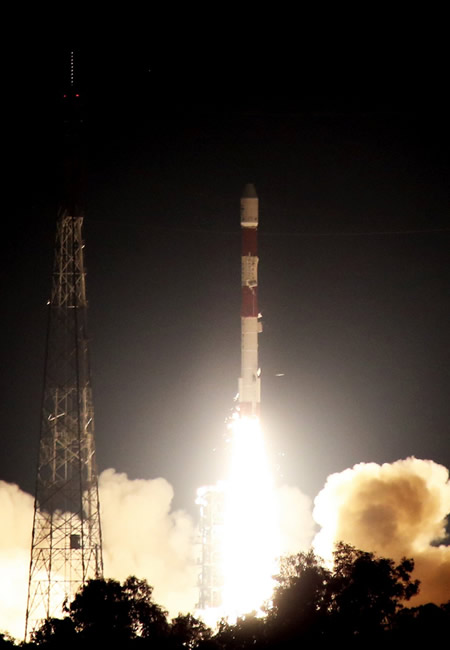« UN Secretary-General Issues Warning about Dangers of Climate Change | Main | United Nations General Assembly holds the Closing Plenary Meeting of the Seventy-second Session »
September 17, 2018
Indian Space Research Organisation launches 2 Foreign Satellites

Photo: Polar Satellite Launch Vehicle (PSLV-C42) of Indian Space Research Organisation (ISRO) lifting off from the Satish Dhawan Space Centre (SDSC) SHAR, Sriharikota, Andhra Pradesh, India, on September 16, 2018.
The Polar Satellite Launch Vehicle (PSLV-C42) of Indian Space Research Organisation (ISRO) successfully launched two satellites — NovaSAR and S1-4— from the Satish Dhawan Space Centre (SDSC) SHAR, Sriharikota today.
The PSLV-C42 lifted off from the First Launch Pad of SHAR at 10.08 pm (IST). Both satellites were injected into the Sun Synchronous Orbit, about 17 minutes later, at an altitude of 583 km.
The satellites belong to UK-based Surrey Satellite Technology Limited (SSTL), which has a contract with Antrix Corporation Ltd, the commercial arm of ISRO. NovaSAR carries S-band Synthetic Aperture Radar (SAR) and an Automatic Identification Receiver payloads. The satellite applications include forestry mapping, land use and ice cover monitoring, flood and disaster monitoring, and maritime missions. SSTL’s Spacecraft Operations Centre in Guildford, UK will operate it.
S1-4 is a high-resolution earth observation satellite meant for surveying resources, environment monitoring, urban management, and disaster monitoring.
The PSLV launch vehicle consists of four stages, each of which is a self-contained vehicle capable of functioning independently with own propulsion systems.
Preparations for the PSLV-C42 began at Sriharikota in mid-July with the process of vehicle integration setting the tone for the launch. Many centers of ISRO contributed to this mission with the vehicle being designed and developed by Vikram Sarabhai Space Centre, Thiruvananthapuram. The second and fourth stage liquid engines came from Liquid Propulsion Systems Centre, Thiruvananthapuram and ISRO Propulsion Complex, Mahendragiri, Tamil Nadu.
The vehicle’s guidance system is from ISRO’s Inertial Systems Unit, Thiruvananthapuram, while SDSC SHAR was responsible for the solid motor preparation, vehicle integration and launch infrastructure. ISRO’s Telemetry Tracking and Command Network provided tracking support.
ISRO Chairman Dr. K. Sivan congratulated the team soon after the successful mission.
“I am delighted that the PSLV-C42 precisely launched two of our customer satellites at 583 km orbit. It was a unique night mission executed for the first time by us. The PSLV has proven yet again as a user-friendly vehicle in all aspects. The credit goes to the entire ISRO team and industries. We are going to have 18 missions in the next six months, virtually one launch every two weeks,” Dr. Sivan said.
“The PSLV-C42 marks the latest technology and commercial collaboration between India and the UK with the launch of the combination of high resolution optical and radar (SAR) satellites from us,” said Sir Martin Sweeting, Group Executive Chairman, SSTL.
As on date, ISRO has launched 239 foreign satellites from 28 countries.
Source: Department of Space, Government of India.
|GlobalGiants.Com|







Edited & Posted by the Editor | 2:46 AM | Link to this Post






